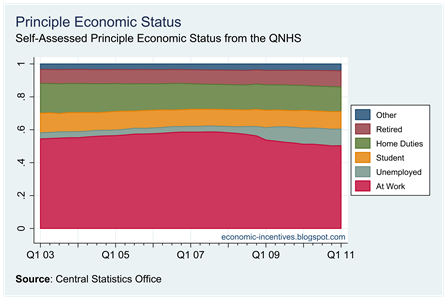The QNHS is used as the primary measure of unemployment in Ireland. We already saw that there may be some issues with the method used by the CSO to estimate the seasonally adjusted unemployment rate. A second issue emerges when we consider the definitions of employment and unemployment used by the CSO.
In Employment: Persons who worked in the week before the survey for one hour or more for payment or profit, including work on the family farm or business and all persons who had a job but were not at work because of illness, holidays etc. in the week.
Unemployed: Persons who, in the week before the survey, were without work and available for work within the next two weeks, and had taken specific steps, in the preceding four weeks, to find work.
Working for one hour in the week prior to the survey means that the respondent is classified as employed. The QNHS includes an additional question that asks people so self assess “their usual situation with regard to employment” and gives the following response categories:
- At work
- Unemployed
- Student
- Engaged on home duties
- Retired
- Other
Using this measure there are 352,000 people who classify themselves as unemployed which differs from the 295,000 people on which the 14.0% unemployment rate. Here are the proportions of the above categories for the population aged over 15 since 2003.
The changes may not be as pronounced as some might expect but the largest change since 2007 is obviously the drop in those at work and the rise in those unemployed. Since Q4 2007 the proportion at work has fallen from 58.6% to 50.4%. Most of this reduction has been picked up in the proportion unemployed which has risen from 3.5% to 10.0%. The other categories are largely unchanged.
The 352,000 people who classify themselves as unemployed further belies the claims by many that there are 450,000 people unemployed in Ireland based erroneously on the numbers on the Live Register. The Live Register is not an accurate measure of unemployment. However, as we saw previously we could be closer to this 450,000 figure if many of those who have left employment had not also left the country (and in the majority of cases these were non-Irish nationals).
Any claims that there are 450,000 unemployed are wrong. The “official” figure is 295,000 and the “self-assessed” figure is 352,000.
If we use the sum of those who classify themselves as at work or unemployed as a measure of the labour force then the implied unemployment rate from this question in the QNHS is 16.1%. The headline rate might be showing some improvement but that is not reflected in how respondents to the QNHS see their reality.
Nor is there any improvement when we look at those at work.
Using these measures it appears that the labour market is not getting any worse, but not getting worse is not the same as getting better. Hopefully this stabilisation will convert to improvement over the coming quarters.
Tweet





Could it be that the the major difference between the 440,000 Register figures and the QNHS survey is accountd for by:
ReplyDeleteThe number of casual and part-time workers on the Live Register increased
over the year by 6,058 (+7.7%) to 84,933. Casual and part-time workers in
May accounted for 19.3% of those on the Live Register, an increase from
12.1% three years earlier.:
People on three days / short time would not describe themselves as unemployed to a survey but still register for JB.
Hi Joseph,
ReplyDeleteThat is it exactly. Ireland is in the unusual position where there are more people claiming unemployment benefits that people unemployed. The OECD commented on this a few weeks ago.
This still does not stop people using the Live Register figure as if it was a measure of unemployment. I listened a number of discussions of the QNHS figures during the week and the 450,000 figure for the number unemployed was often used. Not once was it corrected.